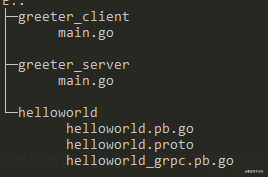gRPC是什么
官方介绍:
https://grpc.io/docs/what-is-grpc/introduction/
“A high-performance, open-source universal RPC framework”
- 多语言:语言中立,支持多种语言。
- 轻量级、高性能:序列化支持 PB(Protocol Buffer)和 JSON,PB 是一种语言无关的高性能序列化框架。
- IDL:基于文件定义服务,通过 proto3 工具生成指定语言的数据结构、服务端接口以及客户端 Stub。
- 设计理念
- 移动端:基于标准的 HTTP2 设计,支持双向流、消息头压缩、单 TCP 的多路复用、服务端推送等特性,这些特性使得 gRPC 在移动端设备上更加省电和节省网络流量。
- 服务而非对象、消息而非引用:促进微服务的系统间粗粒度消息交互设计理念。
- 负载无关的:不同的服务需要使用不同的消息类型和编码,例如 protocol buffers、JSON、XML 和 Thrift。
- 流:Streaming API。
- 阻塞式和非阻塞式:支持异步和同步处理在客户端和服务端间交互的消息序列。
- 元数据交换:常见的横切关注点,如认证或跟踪,依赖数据交换。
- 标准化状态码:客户端通常以有限的方式响应 API 调用返回的错误。
小结
- grpc是个协议,对应的是proto文件
- protobuf 是将jrpc转化为代码的工具
安装
grpc包
go get -u google.golang.org/grpc
protobuf
go install google.golang.org/grpc/cmd/protoc-gen-go-grpc
protoc语法
- -I 参数:指定import路径,可以指定多个-I参数,编译时按顺序查找,不指定时默认查找当前目录
- --go_out :golang编译支持,支持以下参数
- plugins=plugin1+plugin2 - 指定插件,目前只支持grpc,即:plugins=grpc
- M 参数 - 指定导入的.proto文件路径编译后对应的golang包名(不指定本参数默认就是.proto文件中import语句的路径)
- import_prefix=xxx - 为所有import路径添加前缀,主要用于编译子目录内的多个proto文件,这个参数按理说很有用,尤其适用替代一些情况时的M参数,但是实际使用时有个蛋疼的问题导致并不能达到我们预想的效果,自己尝试看看吧
- import_path=foo/bar - 用于指定未声明package或go_package的文件的包名,最右面的斜线前的字符会被忽略
- 末尾 :编译文件路径 .proto文件路径(支持通配符
protoc --go_out=. example.proto
protoc --go-grpc_out=. example.proto
demo

proto文件
syntax = "proto3";
# 定义了包名
package helloworld;
// The greeting service definition.
service Greeter {
// Sends a greeting
rpc SayHello (HelloRequest) returns (HelloReply) {}
}
// The request message containing the user's name.
message HelloRequest {
string name = 1;
}
// The response message containing the greetings
message HelloReply {
string message = 1;
}
生成
protoc --go_out=. helloworld.proto
protoc --go-grpc_out=. helloworld.proto
会多了两个文件

服务端
package main
import (
"context"
"log"
"net"
"google.golang.org/grpc"
pb "google.golang.org/grpc/examples/helloworld/helloworld"
)
const (
port = ":50051"
)
// server is used to implement helloworld.GreeterServer.
type server struct {
pb.UnimplementedGreeterServer
}
// SayHello implements helloworld.GreeterServer
func (s *server) SayHello(ctx context.Context, in *pb.HelloRequest) (*pb.HelloReply, error) {
log.Printf("Received: %v", in.GetName())
return &pb.HelloReply{Message: "Hello " + in.GetName()}, nil
}
func main() {
lis, err := net.Listen("tcp", port)
if err != nil {
log.Fatalf("failed to listen: %v", err)
}
s := grpc.NewServer()
pb.RegisterGreeterServer(s, &server{})
if err := s.Serve(lis); err != nil {
log.Fatalf("failed to serve: %v", err)
}
}
注意
服务端其实是实现协议中的接口,即实现所有方法
type HelloServer interface {
// 定义SayHello方法
SayHello(context.Context, *HelloRequest) (*HelloResponse, error)
mustEmbedUnimplementedHelloServer()
}
很多教程实现了mustEmbedUnimplementedHelloServer 这个方法,但是由于是小写, 同目录下是好的,跨了目录就会有问题。
应该直接:
type server struct {
pb.UnimplementedGreeterServer
}
客户端
package main
import (
"context"
"log"
"os"
"time"
"google.golang.org/grpc"
pb "google.golang.org/grpc/examples/helloworld/helloworld"
)
const (
address = "localhost:50051"
defaultName = "world"
)
func main() {
// Set up a connection to the server.
conn, err := grpc.Dial(address, grpc.WithInsecure(), grpc.WithBlock())
if err != nil {
log.Fatalf("did not connect: %v", err)
}
defer conn.Close()
c := pb.NewGreeterClient(conn)
// Contact the server and print out its response.
name := defaultName
if len(os.Args) > 1 {
name = os.Args[1]
}
ctx, cancel := context.WithTimeout(context.Background(), time.Second)
defer cancel()
r, err := c.SayHello(ctx, &pb.HelloRequest{Name: name})
if err != nil {
log.Fatalf("could not greet: %v", err)
}
log.Printf("Greeting: %s", r.GetMessage())
}
常见的坑
- grpc版本和protoc的版本不一致,如果是第一次用,就都用最新的就好了,后面就一直用这个版本。或者换最新版本重新生成代码文件。
结语
- 如果有不对的地方欢迎指正。
- 如果有不理解的地方欢迎指出我来加栗子。
- 如果感觉OK可以点赞让更多人看到它。